Self-driving vehicles have been developed in many places, over many years, but few people have as strong a claim as Anthony Levandowski to being considered their inventor. And it all started with a phone call from his mother.
“My mom called me up and said, there’s this robot race it would be interesting for you to find out about,” he recalls. That race was the 2004 Grand Challenge, the first of three long distance contests for driverless cars organised by the Pentagon’s research arm, Darpa. “I was like wow, this is absolutely the future.”
With the help of fellow engineers at the University of California, Berkeley, Levandowski built Ghostrider, a 90cc Yamaha motorbike modified to balance and ride itself using motion sensors, video cameras and GPS. He chose a nimble two-wheeler because he thought better funded teams would quickly get four-wheeled driverless vehicles working perfectly.
“I expected the problem to be solved on cars on race day,” says Levandowski. “That was a huge miscalculation because 12 years later, it’s still not solved.” None of the dozens of competing vehicles finished the course, and Ghostrider (which is now in the Smithsonian) did not even make the final. But Levandowski had found his life’s calling. “It struck a chord deep in my DNA,” he says, “It was almost like discovering electronics. I didn’t know where it was going to be used or how it would work out, but I knew that this was going to change things significantly.”
Fast forward to this 2016 – and that significant change is happening. Uber just announced that self-driving cars will start pick up passengers later this month in Pittsburgh. And the man leading the project, alongside Uber’s multi-billion dollar efforts to automate long-distance trucking, delivery and passenger services? Anthony Levandowski.
“In 30 years, every single new car will be autonomous. That’s completely obvious,” says Levandowski, who was also the engineer responsible for Google’s first driverless car. “But it will take a long time for the technology to be ubiquitous. It’s probably one of those things where we overestimate it in the short run and underestimate it in the long run.”
Relationship with Google
Levandowski himself could not be accused over underestimating the potential of robotic vehicles. After building Ghostrider, he put the first driverless car on public roads in 2008, and sold a start-up to Google that formed the nucleus of its self-driving car project. His latest venture, an autonomous truck company called Otto that only launched in May, is being bought by Uber for an estimated $680m.
It was at a second Darpa race, back in 2005, that Levandowski met Sebastian Thrun, a Stanford computer science professor. Thrun eventually recruited him to Google, to work together on its Street View mapping project.
“After a year of doing that, the robot itch came back,” says Levandowski. A TV producer friend suggested that Levandowski build a self-driving pizza delivery vehicle for the Discovery Channel show Prototype This! “Google was very supportive of the idea, but they absolutely did not want their name associated with it,” he says. “They were worried about a Google engineer building a car that crashes and kills someone.”

So Levandowski set up another company, called Anthony’s Robots, to keep the technology giant at arm’s length. In less than a month, Levandowski and engineers had built the Pribot – a self-driving Toyota Prius with one of the first spinning lidar laser ranging units, and the first ever to drive on public roads.
On the day of the shoot, San Francisco police closed a five mile route to traffic as the Pribot could not yet detect other vehicles or pedestrians. The car made the trip almost without incident, just scraping a tight exit on the Bay Bridge. “You’ve got to push things and get bumps and bruises along the way,” says Levandowski. “But we did it in four weeks and that really got me jazzed about going back to robots.”
Google founders Larry Page and Sergey Brin were pretty jazzed, too. They gave Levandowski the budget to bring the Pribot into a secretive new unit of Google called X, dedicated to “moonshot” technologies and headed by Thrun. Within a couple of years, Google had quietly acquired both of Levandowski’s companies, Anthony’s Robots and 510 Systems.
Although some of the startups’ engineers wanted to work on self-driving vehicles on their own, Levandowski has no regrets to selling up. “Google was the right place to pioneer robot cars,” he says. “In 2008, no one else would ever have believed me that we were going to make a car actually drive everywhere, all the time.”
For the next couple of years, until a story in the New York Times revealed their existence, Google’s growing fleet of Priuses roamed the streets of California without anyone noticing. “If people asked us what was on the cars, we’d say, it’s a laser and just drive off,” says Levandowski with a laugh.
Uber buys Otto
In 2011, Levandowski helped lobby the state of Nevada to allow the testing of autonomous vehicles, and even put a Prius through the world’s first self-driving test to demonstrate its safety. “Nevada was all about removing an excuse for the engineers to not ship the technology,” he says. “But that’s when I realised it wasn’t ready. It was clear we had to do more work to improve the technology’s reliability.”
For the next five years, Levandowski helped Google expand its fleet to dozens of vehicles, including prototype self-driving cars without manual steering wheels, brakes or accelerators. In January this year he left to found Otto, a startup dedicated to giving truckers the freedom to take naps during long distance highway drives. Uber agreed to buy the company in late July, with Levandowski reporting direct to Uber founder Travis Kalanick.
Levandowski admits there are technical challenges to perfecting self-driving taxis like those Uber is developing. “Surface streets are probably a hundred to a thousand times more complicated than highways,” he says. But he is confident that autonomous vehicles will eventually “save on average more lives than any other technology that’s been created before”.
He also thinks that any legal and regulatory hurdles that exist today will melt away once the superior performance of self-driving cars is demonstrated. “As soon as it’s ready, it’s going to be legal. If we can show it’s safe, there’s no reason why it should not be allowed,” he says. “There will be fewer deaths, and we can’t stand in the way of that. Robots here we come!”

Comments (…)
Sign in or create your Guardian account to join the discussion